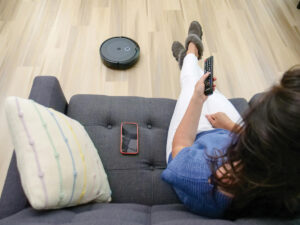As homeowners look for new ways to save energy at home, there are many cutting-edge technologies currently being developed to become the latest way to improve the efficiency of your home.
Magnetic refrigerators
Refrigerators are essential for any modern home and typically use a good deal of energy to properly cool your food. Reducing the amount of energy your refrigerator uses can help lower your home energy consumption. One emerging technology is the magnetic refrigerator. Most refrigerators use a traditional compressor to cool perishables, but magnetic refrigerators use a magnetic field as an innovative way to cool food.
This is possible through a phenomenon called the “magnetocaloric effect” which causes certain materials to cool down when a magnetic field is removed. This creates a more energy-efficient refrigerator, using approximately 30 percent less energy than traditional ones. Magnetic refrigerators also remove the need for harmful chemicals used in traditional refrigerants, making them more environmentally friendly.
There are a few magnetic refrigerators commercially available, however the market is still limited. Researchers and universities are working to improve this technology with the goal to make the commercial market for magnetic refrigerators more widespread.
Cool roofs
When temperatures are highest, choosing the right roofing material can make a huge impact on how much heat your home absorbs. Certain types of roofing can reflect more sunlight than others, helping to keep your home cooler and reducing your need for air conditioning. These “cool roofs” are specifically designed to absorb less heat and reflect more sunrays than traditional roofs.
Cool roofs are lighter in color and can use reflective paint, highly reflective tiles or a reflective sheet covering. There are several types of cool roofs commercially available, and choosing the right type partially depends on the steepness of your roof’s slope. Low-sloped roofs are better suited for reflective sheet membranes, while high-sloped roofs work better with reflective shingles and tiles.
Although cool roofs can reduce heat, the overall heat savings you can achieve from roofing depends on home insulation, climate and a few additional factors. If you’re considering a new roof for your home, a cool roof may be a great option to reduce energy use.
Heat pump dryers
A heat pump clothes dryer can help reduce energy use in the laundry room by at least 28 percent compared to standard dryers. Instead of releasing warm, humid air through a vent outside the home, heat pump clothes dryers work by sending humid air through an evaporator that removes moisture without losing too much heat.
Heat pump dryers do not require outside ventilation like standard dryers, which is a major efficiency benefit. Additionally, since these dryers use lower temperatures, they are gentler on clothes. Several commercial brands like Whirlpool and Samsung sell ENERGY STAR-certified heat pump dryers, and the cost typically ranges from $900 to $1,500 depending on additional features.
These emerging technologies are among the newest available to reduce your energy use at home, but because they are new, they will come with higher sticker prices than their conventional counterparts. As with any new technology, prices will become more affordable as these efficiency options become more mainstream. When considering new technologies, make sure you fully understand the costs and benefits over time to get the best value.
Photo (above): When it’s time for a new roof, consider a “cool roof” for maximum energy savings. Cool roofs are lighter in color and can use reflective paint, highly reflective tiles or a reflective sheet covering, like the metal roof shown here. Photo Credit: McElroy Metal








